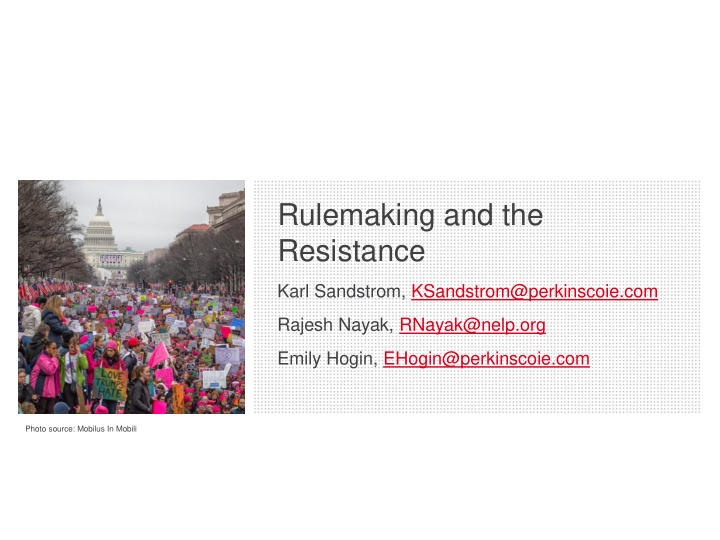



Rulemaking and the Resistance Karl Sandstrom, KSandstrom@perkinscoie.com Rajesh Nayak, RNayak@nelp.org Emily Hogin, EHogin@perkinscoie.com Photo source: Mobilus In Mobili Perkins Coie LLP | PerkinsCoie.com
The Resistance Needs to Pay Attention to Agencies 2 Perkins Coie LLP | PerkinsCoie.com
The Rulemaking Process
Why Make a Rule?
www.reginfo.gov
Prerule Consultation
Develop Proposed Rule
Issue Proposed Rule
What’s in a Proposed Rule? Background Section-by-Section Analyses Proposed Regulatory Text
Public Comments
Develop Final Rule
Issue Final Rule (with Effective Date)
Judicial or Legislative Challenges
Public Comment is a Huge Opportunity! 14 Perkins Coie LLP | PerkinsCoie.com
Where to find Proposed Rules: Federal Register 15 Perkins Coie LLP | PerkinsCoie.com
Where to find Proposed Rules: Regulations.gov 16 Perkins Coie LLP | PerkinsCoie.com
Submit Comments Online 17 Perkins Coie LLP | PerkinsCoie.com
Examples of public comments CFPB proposed rule: publish online “unstructured consumer complaint narrative data” (i.e., raw complaints from consumers) 18 Perkins Coie LLP | PerkinsCoie.com
Special Interests Were Ready 19 Perkins Coie LLP | PerkinsCoie.com
The General Public? Less Helpful 20 Perkins Coie LLP | PerkinsCoie.com
Think Like a Litigator, Write Like an Expert 1. Read the STATUTE, then the RULE and any accompanying documents (like an “E&J”) 2. Ask yourself: ➢ Does the agency’s interpretation of the statute make sense? ➢ Can you point to where in the statute the agency has the power to make all of its choices? Is it going beyond the statute? ➢ Are there parts of the statute the agency is ignoring? 21 Perkins Coie LLP | PerkinsCoie.com
Think Like a Litigator, Write Like an Expert — Continued ➢ What evidence is the agency relying on? Is that evidence the most credible? ➢ Does the agency’s rule fit the evidence it cites? ➢ Is the agency ignoring important evidence that you know? ➢ Has the agency considered important alternative choices? Does the agency’s rejection of those alternatives make sense? ➢ Is the agency departing from past practices? Has it explained in a detailed way why the change? 22 Perkins Coie LLP | PerkinsCoie.com
Important Administrative Law Cases • Chevron , 467 U.S. 837 (1984) and Auer , 519 U.S. 452 (1997) • Massachusetts v. EPA , 549 U.S. 497 (2007) • Brown & Williamson , 529 U.S. 120 (2000) / Utility Air , 134 S. Ct. 2427 (2014) • State Farm , 463 U.S. 29 (1983) • Business Roundtable , 647 F.3d 1144 (D.C. Cir. 2011) • FCC v. Fox , 567 U.S. 239 (2012). 23 Perkins Coie LLP | PerkinsCoie.com
To-Do 1. Bookmark federalregister.gov and regulations.gov. Get in the habit of keeping up with proposed rules. 2. Find partners, like law professors or local organizations, who can help you understand the policy and sign your public comments. 3. Study up on the Administrative Procedure Act, and keep an eye out for potential litigation. 4. Reach out to ACS at LCEmails@acslaw.org to volunteer to monitor specific policy areas in the Federal Register for comment opportunities. 24 Perkins Coie LLP | PerkinsCoie.com
Recommend
More recommend